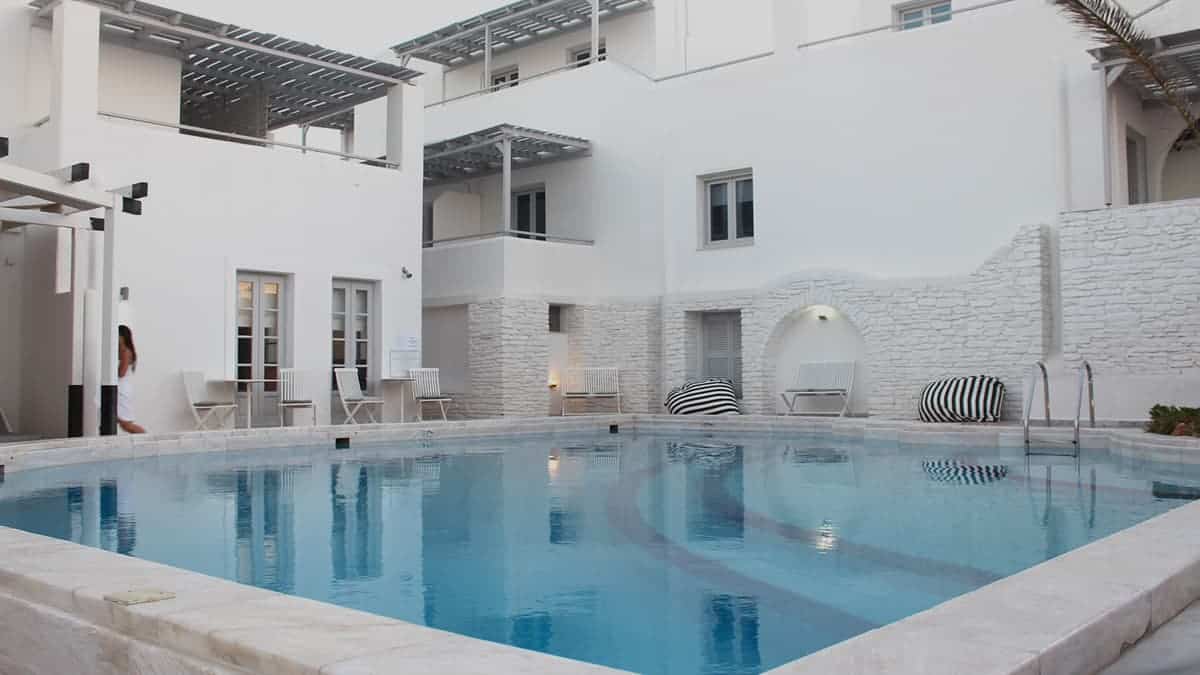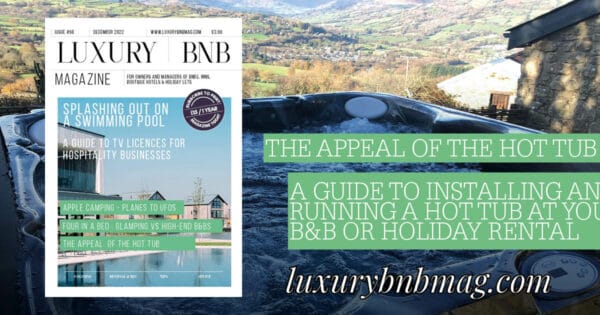
As high-end hospitality venues vie for a regular share of the UK tourism market against a backdrop of rising inflation and high fuel prices, they may consider installing hot tub facilities for their guests. Dominic Johnson reports on cost and other considerations.
The appeal of a hot tub in a hospitality setting is dramatic. You only need to watch an episode of Four in a Bed featuring a property that offers hot tubs to their guests to see their appeal, as competing guests melt with passion and relax as they immerse themselves in bubbling hot water at the end of a long day hiking.
Hot tubs are certainly not cheapest of guest facilities, nor are they particularly cheap to run if they face regular use, but they certainly offer strong if not universal appeal.
It may seem hard to believe, but according to BISHTA, despite the unpredictable British weather, one in 10 people now have access to a hot tub in their garden.
Turn this figure around and it still means that some nine out of 10 people do not have such luxury access, and therein lies much of the appeal of a hot tub facility in a luxury B&B or other holiday accommodation.
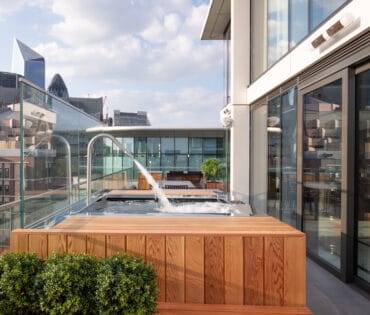
How much does a hot tub cost to run at your B&B?
The key factors to take into account when it comes to how much it costs to run a hot tub and electrical running costs, servicing and maintenance and regular additional costs such as water care products.
The energy costs depend very much on the size and type of hot tub, the temperature outdoors, the frequency of use, the length of time they are used, the length of time the jets are used during each use, the water temperature you choose and of course your electricity tariff.
Given the changing nature of energy costs at the moment, and the question as to whether you use a hot tub that requires its own power supply, it is too much to generalise when it comes to cost. However, you might be safe to assume each hot tub will be used three or four times a week at roughly 4 kilowatts per hour.
Given the significant cost of electricity it is important you look at the energy label before you buy. If you order something manufactured in, say, China, you need to check it is not going to be draining your electricity at a rate of five times that of a domestically made energy efficient model. But note that while hot tub heaters come in a variety of kW ratings, this won’t directly affect their energy usage, since a heater with a larger kW rating will heat the water faster, but it won’t need to stay on as long. hot tubs heat the spa water to your preferred temperature, typically between 37°C and 39°C, and it stays at this set temperature until it is turned off.
The larger your hot tub and the more water it holds, the more it costs to run. You are advised to choose a hot tub of 200-250 litres of water capacity per bather seat, according to a recent report by What Spa?
Unless you need a huge party spa, there’s no point buying a hot tub that is much bigger than you need for your average number of regular bathers. Alternatively, you may choose small hot tubs for your guests. Cheaper to buy, install and run. But not quite as glam.
At a time of stark competition and falling occupancy rates, if you have the space and the cash to install a hot tub the proposition is pretty much a no-brainer. Your property will stand out a mile, in or out of season.
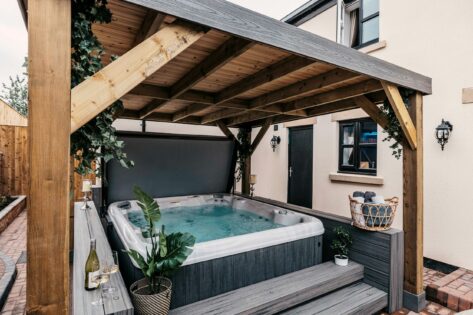
Hot tubs explained
An overview from BISHTA, the trade association that represents the British and Irish hot tub and Swim Spa Industry.
In some parts of the world, such as Scandinavia, the term ‘hot tub’ is only used to refer to wooden equipment used with a stove, while in other parts of the world such as North America the term ‘Spa’ I used to mean any type of equipment, whether made of wood, acrylic or other materials.
A hot tub is typically made from either wood or thermoplastic composites including acrylic and vinyl. hot tubs come complete with heating and filtration built-in making them very straightforward to both purchase and install. Added extras such as sound systems, DVD / CD players, TV and lighting features are widely available. Look for the logo and name displayed by members of BISHTA (The British and Irish Spa and hot tub Association) when buying a portable hot tub, or visit our website at www.bishta.co.uk to find loc al BISHTA members on our easy search map.
hot tubs can be installed in the garden, on a terrace, in a conservatory or in a home extension. By usually being above ground (rather than in-ground), this gives you more flexibility about positioning, with the added advantage of being a ble to take it with you if you move house, but please remember they are heavy items and may require specialist lifting equipment. Simple to run, a basic hot tub can be purchased for under £5,000.
BISHTA warns that careful consideration would need to be mad e for rigid hot tubs costing less than £3,500. There is likely a reason they are at this price point (regarding build quality and/or energy efficiency).
Often it is either that the components are not of the same quality (such as not selling the hot tub wit h a safety cover or lower levels of insulation), What is the difference between a hot tub and a Spa? (C8)
Domestic self- contained spas are usually referred to as `hot tubs` here in the UK, to avoid confusion with the terms “spa” which is usually thought of as some kind of hotel venue where you get pampered! Quite often, people enjoy the benefits of being in warm water at a Hotel or Fitness club and decide they want to replicate the experience in their own home. – meaning the hot tubs will be much more costly to run than a well – insulated version, or the seller may also be offering very limited warranties (and if things go wrong, then they may have no system for picking up warranty claims). Energy costs are an essential consideration. Therefore, it is worth paying a little more for a well – insulated hot tub; otherwise, the extra running costs for poorly insulated hot tubs will soon add more money overall.
Expect to budget an average of at least £2.50 ‘per half an hour per day’ for the smaller efficient models to maintain at a comfortable 40°C. Running costs for exercise spas may require upwards of £5.00 – £7.00 ‘per half an hour per day’. It is sensible for buyers to ask the retailer for information on their products’ energy efficiency and the average running costs associated with using the product before they purchase.
BISHTA members can provide hot tub and spa buyer s with a trusted source of purchase and can offer advice on the most efficient hot tubs available and cost -effective ways to run them.
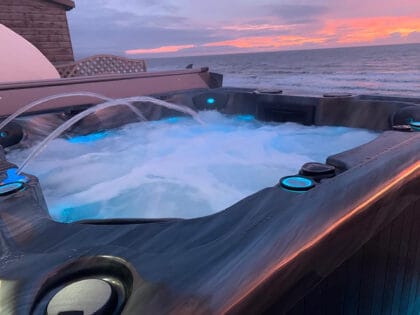
Swimming against the tide
Another option that you may decide to consider is a Swim/Exercise Spa, as they are great for those who enjoy swimming, but who do not have room for a swimming pool. A Swim/Exercise Spa can provide the experience of swimming the English Channel in an area often no bigger than 8`x 6`!
Swim/Exercise Spas pumpa turbulent flow of water from outlets along one side of the pool offering a similar sensation to swimming against the flow in a mountain stream. Swimming against the current offers all the benefits of a full exercise swim without moving an inch.
Whether you prefer a leisurely doggy paddle or a competition standard sprint, the water flow can be adjusted to match your exercise needs. Air can also be mixed with the water giving added buoyancy and some models offer an underwater massage facility.
Swim/Exercise Spas allow you to swim against a continuous stream of water, it’s basically a swimming treadmill.
You do not have to complete laps or turn around like in a normal pool, but just have to keep exercising within the space provided to ensure you get the swimming exercise you need.
It provides a whole range of aqua aerobics activities, from swimming to weight resistance training, to waterjogging, making it the ideal therapeutic tool for tired bodies. It has been found to be effective for those recuperating from any sports injuries . The reason is that these units have been designed so that you can indulge in strenuous water -based activities and the flow of the water jets can also be fine-tuned to deliver just the right force and direction.
To make exercise even easier, manufacturers are offering a vast selection of underwater exercise equipment, such as resistance bands, which make it possible to target muscle groups that standard swim strokes do not.
In terms of space, they only need about 4–8 metres in length and 2.5 –3.5 metres width. Since they are self-contained, they are quicker and easier to install than most pools. The cost of a Swim/Exercise Spa is anywhere between £15,000 and £50,000.
hot tubs and Swim/Exercise spas are a healthy and natural way to relax and are a great addition to any home or garden to enhance your lifestyle. With a huge variety of shapes, sizes, colours and styles you can be sure that somewhere there is an option to suit every situation!
Children delight in them, parents love them and older people derive great benefit from the massaging waters, it is pure hot tub (or Swim/ExerciseSpa)
Heaven!
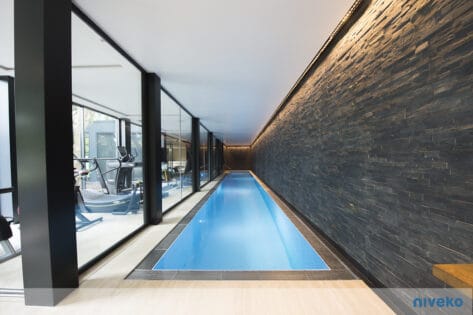
Wood-fired hot tubs used in Business Settings
With business owners considering offering their guests wood-fired hot tubs, BISHTA warns that they are only considered suitable for business settings such as holiday parks, rentals and holiday accommodation when they are going to be drained and cleaned at least every three to five hours, depending on the water source used.
Wood-fired hot tubs are officially referred to as ‘Scandinavian hot tubs’ in the relevant European standard EN 17125. They are spas designed for single use of the water, where the water temperature is increased from an external heat source such as a wood-fired stove. They are sited out of doors, and the water is only left in the hot tub for a few hours before it needs to be drained to avoid the build-up of any infectious agents in the water that might be harmful to bathers.
This hot tub design typically has no circulation and filtration system and no chemical treatment for disinfection – although crucially some manufacturers modify what they offer, so you are advised to check this out with the manufacturer or the retailer. hot tubs are also not typically equipped with heat controls or automatic means of controlling the upper temperature of the water, and they require manual water temperature measurement and heating adjustment.
Although they are not specifically mentioned in the guidance set out in HSG 282, the HSE has confirmed to BISHTA that as they are spa pool systems that can attract infectious agents, their guidance is applicable.
The increased risks that can arise from the lack of water disinfection and any automatic safeguards for not exceeding a safe water temperature include rapid bacterial growth leading to potential infection and a scalding risk.
Depending on the water source used, that is to say potable or non-potable, the water should be held in the hot tub for a maximum of five hours for potable drinking water, which complies with national water drinking regulations, or a maximum of three hours for non-treated and non-potable water. When using non-potable water, without any disinfection, the bathing time should not exceed one hour, and the heating time should not exceed two hours to minimise the growth of harmful bacteria – hence the maximum total of 3 hours.
Depending on the safety features in the hot tub design, the chimney heating the hot tub water may get very hot, so this needs some form of protection. These hot parts, especially the lowest 1,000 mm of the chimney, should be protected from accidental contact, according to EN ISO 13732-1.
For more information on using Wood-fired (Scandinavian hot tubs) in business settings, please contact BISHTA by phone at 01264 356211 or by email at admin@bishta.co.uk.



